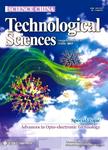Conditioning treatments mitigate the levels of fecal pollution indicators in soil during land-application of sewage sludge
作者机构:Department of Environmental EngineeringCollege of Resources and Environmental SciencesNanjing Agricultural University College of Materials and Chemical EngineeringPingxiang University Jiangsu Collaborative Innovation Center for Solid Organic Waste Resource Utilization
出 版 物:《Science China Technological Sciences》 (中国科学:技术科学(英文版))
年 卷 期:2024年第67卷第10期
页 面:3091-3102页
核心收录:
学科分类:12[管理学] 083002[工学-环境工程] 1204[管理学-公共管理] 0830[工学-环境科学与工程(可授工学、理学、农学学位)] 082803[工学-农业生物环境与能源工程] 08[工学] 0828[工学-农业工程] 120405[管理学-土地资源管理]
基 金:supported by the National Natural Science Foundation of China (Grant Nos. 21976091 and 42207292) the Natural Science Foundation of Jiangsu Province (Grant Nos. BK20230040 and BK20220364)
主 题:fecal pollution indicators sewage sludge conditioning treatment land application soil
摘 要:Sewage sludge is a major source of fecal pathogens in the environment, and its application to land can result in a significant release of these pathogens into the soil. While conditioning treatments are crucial for improving the dewatering process of sludge, their impact on the presence and behavior of fecal pathogens in soil remains unclear. This study aims to assess four extraction methods for recovering fecal pollution indicators from soil amended with unconditioned and conditioned sludge. The indicators include Escherichia coli(EC), human-specific HF183 Bacteroides(HF183), human adenovirus(HAdV), human BK polyomavirus(BKPyV), human JC polyomavirus(JCPyV), and cross-assembly phage(crAssphage). This study also examines how soil moisture content affects the decay of these fecal pollution indicators in soil amended with raw sludge and investigates the influence of conditioning treatments with cationic polyacrylamide(PAM), Fenton s reagents, Fe[Ⅲ]/CaO on their persistence in soil. The results indicated that the direct extraction method was the most effective and unbiased for recovering fecal pollution indicators from sludge-amended soil compared with the three elution-concentration methods. All fecal pollution indicators, except HAdV, remained stable under dry soil conditions, while high soil moisture content(48.39%-53.14%) slowed the decay rates of these indicators. During the application of sludge to soil, effective control of fecal pollution indicators was observed, with JCPyVand HAdV becoming undetectable within a short period. The log reduction values of HF183, BKPyV, and crAssphage ranged from 0.1 to 2.8 logs after 30 d of cultivation. The application of conditioned sludge, especially Fenton s reagent-conditioned sludge, resulted in a reduction in human fecal contamination in the receiving soil. Therefore, implementing appropriate conditioning methods, such as using Fenton s reagent, can effectively mitigate the health risks associated with fecal pathogens.



